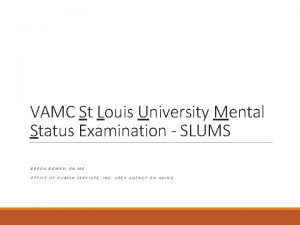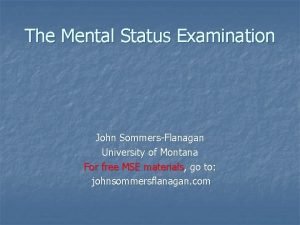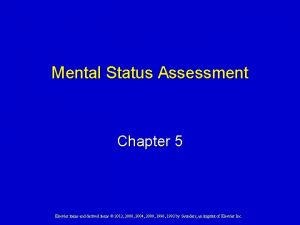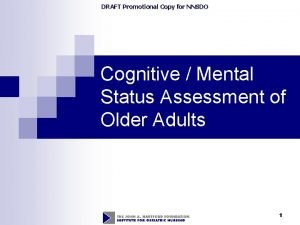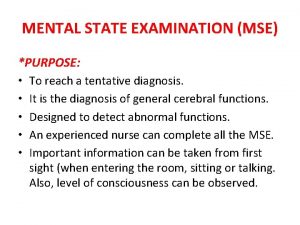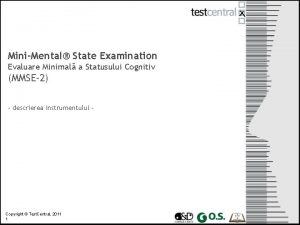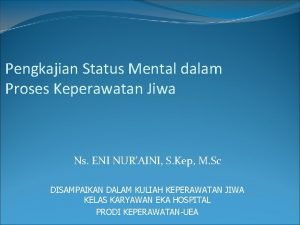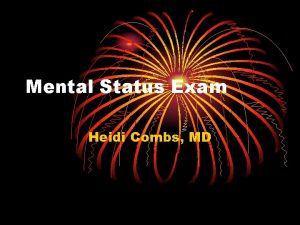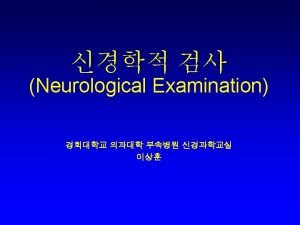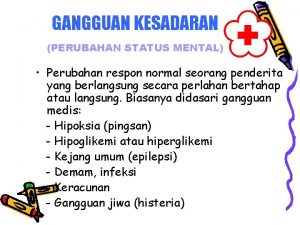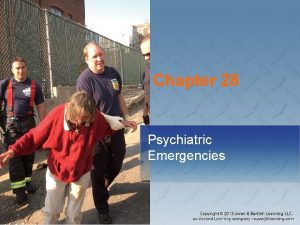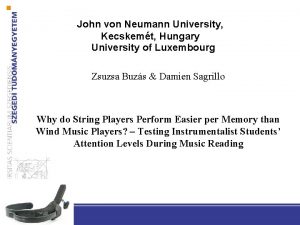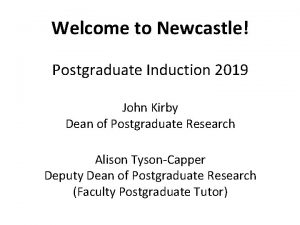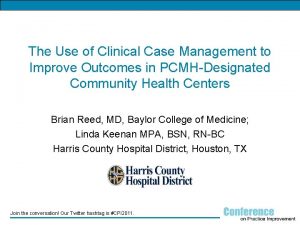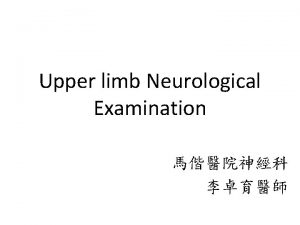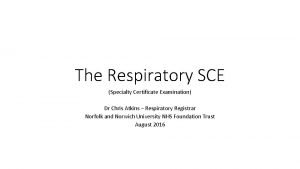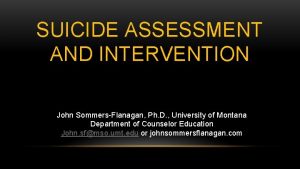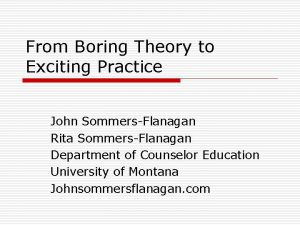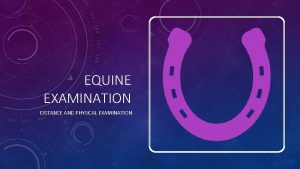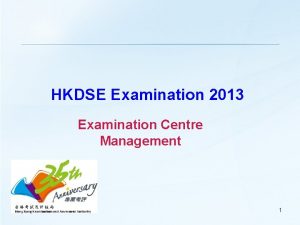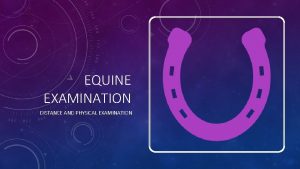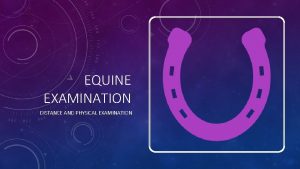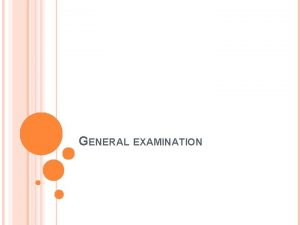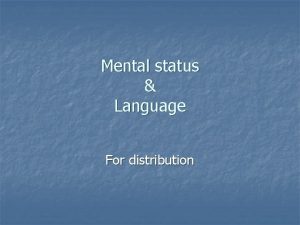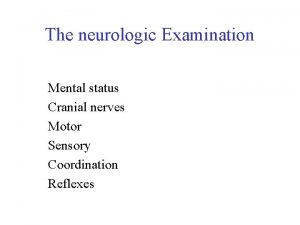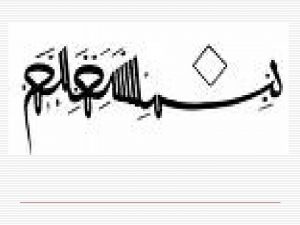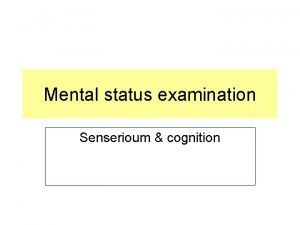The Mental Status Examination John SommersFlanagan University of






































































- Slides: 70

The Mental Status Examination John Sommers-Flanagan University of Montana For free MSE materials, go to: johnsommersflanagan. com

Today’s Plan: Why the MSE? n n The mental status examination (MSE) has a revered place in psychiatry and medicine It’s of growing importance to counseling, psychology, and social work It’s a language we need to be able to use and understand This day focuses on the basic components of a psychiatric mental status examination

Today’s Plan: Learning Objectives n Get comfortable with the MSE terminology n List and define the nine “psychiatric domains” n n Practice collecting, analyzing, and reporting data from each of the nine domains Describe cultural and other validity problems

What Is a Mental Status Examination? n n n The mental status examination (MSE) is an assessment procedure It is a semi-structured interviewing used to organize clinical observations pertaining to mental condition The primary purpose is to evaluate current cognitive processes (how’s your brain? )

MSE – Medical Perspective n n n Medical perspective https: //www. youtube. com/watch? v=Vj. WV Ygf 2 Uc. U 0: 00 – 9: 22

What Is a Mental Status Examination? II n Two types: Psychiatric and neurological n Two approaches: Formal and informal n It’s very common to medical settings n It results in one medium-length paragraph describing the client’s mental status

Sample MSE Report n n Let’s read this together and analyze it Gary Sparrow, a 48 -year-old heterosexual White male, was disheveled and unkempt upon arriving at the hospital emergency room. He wore dirty khaki pants, an unbuttoned golf shirt, and white shoes. He appeared slightly younger than his stated age. He looked agitated, frequently standing up and changing seats. He was impatient and sometimes rude. Mr. Sparrow reported that today was the best day of his life, because he had decided to join the professional golf circuit. His affect was labile, but appropriate to the content of his speech (i. e. , he became tearful when reporting he had “bogeyed number 15”).

Sample MSE Report (cont. ) n His speech was loud, pressured, and overelaborative. He exhibited loosening of associations and flight of ideas; he unpredictably shifted the topic of conversation from golf, to the mating habits of geese, to the likelihood of extraterrestrial life. Mr. Sparrow described grandiose delusions regarding his sexual and athletic performances. He reported auditory hallucinations (God had told him to quit his job to become a professional golfer). He was oriented to time and place, but claimed he was the illegitimate son of Jack Nicklaus. He denied suicidal and homicidal ideation. He refused to participate in intellectual- or memory-related portions of the examination. Mr. Sparrow was unreliable and had poor judgment. Insight was absent.

Assessment in a Nutshell n n Assessment is judgment It is an effort to know something about someone else It is an effort to know something that is true and accurate/consistent about someone (valid and reliable) The MSE is a particular assessment approach

Assessment in a Nutshell n n Every effort to know the truth about someone else falls short. . . Including the MSE Therefore, although assessment is important, we should always be humble and collaborative in our assessment process and in reporting outcomes

Let’s Practice n Volunteer for Mini Mental Status n John administers n You all observe n Then you report in your observations and interpretations

What Was Your Assessment? Observations Hypotheses Interpretations

Case Example I n n You’re working with an 11 -year-old girl. She has atrocious hygiene. She’s bullied. In your first 5 minutes you have her drawa-person and she includes a penis: Observations? Hypotheses? Interpretations or inferences?

Case Example II n n You’re working with a 14 -year-old boy. He got caught setting fires. He got caught throwing cats out an upstairs window. He has enuresis. You meet with him and he’s charming. Observations? Hypotheses? Interpretations or inferences?

Case Example III n In The mental status examination and brief social history in clinical psychology Smith (2011) wrote: n A Fu-Manchu mustache suggests the wearer doesn’t mind being thought of as “bad, ” whereas a handlebar mustache tells you the person may be somewhat of a dandy or narcissist. (p. 4)

Case Example IV n He also wrote: n n “If the person is unshaven, this may be a sign of depression, alcoholism, or other poor ability at social adaptation” (p. 4) What mistake is he making?

Individual and Cultural Considerations n Thinking about Objectivity Total objectivity is impossible n Your mood and beliefs can interfere with or help with your objective mental status evaluations n Be sure to keep your emotional sensitivity in your MSE process n

Individual and Cultural Considerations II n Individual and Cultural Considerations n n Keep in mind the many ways individuals vary in their behavior and abilities Normal behavior within one culture, may appear disturbed or irrational within another culture

The Danger of Single Symptom Generalization n What are some common single symptoms (other than type of mustache ) that clinicians might be prone to overinterpret? Do you have any particular biases about this? Why is it so easy to be overconfident in our judgments?

Three Guidelines n n n When you spot a single symptom of interest, begin scientific-mindedness Remember: Hypotheses are not conclusions Don’t make wild inferential leaps without consulting first

Chinua Achebe (1994) n “After the singing the interpreter spoke about the Son of God whose name was Jesu Kristi. Okonkwo, who only stayed in the hope that it might come to chasing the men out of the village or whipping them, now said:

Chinua Achebe (1994) n n n “You told us with your own mouth that there was only one god. Now you talk about his son. He must also have a wife, then. ” The crowd agreed. “I did not say He had a wife, ” said the interpreter, somewhat lamely. . . The missionary ignored him and went on to talk about the Holy Trinity. At the end of it Okonkwo was fully convinced that the man was mad. (pp. 146– 147)

5 Minute Discussion n Consider the excerpt from the novel “Things Fall Apart” n n What are your thoughts on how the author depicts Christianity as appearing “mad” to a native African? Are there any religious or spiritual or cultural beliefs that you would consider “mad? ”

Mini Mental State n Admin to each other and debrief

The Generic MSE n n n n n Appearance Behavior/psychomotor activity Attitude toward the examiner Affect and mood Speech and thought Perceptual disturbances Orientation and consciousness Memory and intelligence Reliability, judgment, and insight

Watch Carl Video n Use the MSE form to make notes in each category

Appearance n Appearance in a MSE focuses on physical characteristics Grooming n Dress n Make-up n Facial expressions n Weight/height n Body piercing/tattoos n Others? n

Video Clip n Thom or Michele

Sample Appearance Description n Maxine Kane, a 49 -year-old single, selfreferred, Australian American female, appeared much younger than her stated age. She was tall and thin and arrived for the evaluation wearing sunglasses, a miniskirt, spike heels, heavy makeup, and a contemporary bleached-blonde hairstyle.

Behavior or Psychomotor Activity n Behavior or Psychomotor Activity in a MSE focuses on physical movement Excessive or limited movement n Eye contact and eye movement n Grimacing or fidgeting n Gestures n Posture n

Video Clip

Sample Behavior/Psychomotor Activity Description n The client scratched at her legs, back, and stomach throughout the interview. When asked about the scratching, she said “Oh, you wouldn’t believe the mosquito storm I got caught in when I took out the garbage last night. I think I counted 57 bites. ”

Attitude Toward Examiner (Interviewer) n Attitude Toward the Examiner in a MSE refers to how the client behaves toward the interviewer; examples include: n n n n Cooperative Hostile Indifferent Manipulative Open Seductive Suspicious

Video Clip

Sample Attitude Toward the Examiner Description n The client’s attitude toward the examiner was hostile as evidenced by (AEB) repeated eye-rolls, sarcastic comments, and intermittent use of the word “duh. ”

Affect and Mood n Affect and Mood refers to moment-tomoment emotional tone as observed by the interviewer (affect) and the client’s subjective and self-reported mood state Affect is usually judged in terms of content, range/duration, appropriateness, and depth/intensity n Mood is based on client self-report n

Affect Content n n n n Angry Fearful Sad Guilty Joyful Happy Surprise

Affect Range n Labile n Flat n Constricted n Blunted

Affect Appropriateness n Examples: n Possible indicator of: Schizophrenia n Autism n Other? n

Affect Intensity

Affect Terminology n n Euphoric: the client claims omnipotence, exhibits increased psychomotor activity, and has exaggerated gestures). Labile: the client shifts quickly from tears to laughter Inappropriate: the client expresses euphoria over job loss and marital separation Shallow: the client claims to be happy because “I smile” and “smiling takes care of everything”).

Video Clip

Sample Affect Description I n Throughout the examination, Ms. Brown’s affect was occasionally sad, but often constricted. Her affect was appropriate with respect to the content of her speech.

Sample Mood Description I n The client reported, “I feel miserable, unhappy, and Sample Mood Description II: The client’s current mood rating was a 4 on a 0– 10 scale. He reported his 2 -week low as a 3 and his 2 -week high as a 5 and noted this range of 3 to 5 is pretty normal for him. He described his low mood as “irritable” rather than sad. angry most of the time. ”

Speech and Thought n Speech is evaluated on the basis of Rate (speed) n Volume (loudness) n Amount (density) n n Thought is evaluated in terms of both process and content

Thought Process n Thought Process descriptors include: n n n n Blocking Circumstantiality Clanging Loose Associations Neologisms Perseveration Word salad

Thought Content n Thought Content descriptors primarily include: n Delusions (of persecution, grandiosity, etc. ) n Obsessions n Suicidal or homicidal thoughts

Video Clip

Sample Speech and Thought Description n The client’s speech was loud and pressured. Her communication was sometimes incoherent; she exhibited flight of ideas and neologisms as evidenced by her inability to stay on topic and use of words such as “Whaddingy” and “Ordinarrational. ” She didn’t respond coherently to questions about obsessions, but appeared preoccupied with the contents of a small notebook.

MSE and Culture Activity

Perceptual Disturbances n Perceptual Disturbances include hallucinations, illusions, and flashbacks Hallucinations may occur in any sensory modality, but are most commonly auditory n Illusions have some basis in reality n Flashbacks consist of sudden and vivid sensory-laden recollections of previous experiences n

Asking About Perceptual Disturbances n n n Greasing the wheels to help the patient feel comfortable sharing information Uncovering the logic associated with the delusional material Determining the client’s insight and how much distance he/she has from the symptom

Video Clip

Sample Perceptual Disturbances Description n The client spontaneously reported hearing voices in a variety of different settings. These voices usually tell him to “crawl” or “get to your knees” because he is “bad. ” He did not report illusions or flashbacks.

Orientation and Consciousness n Orientation and Consciousness refers to clients’ awareness of themselves and situation n n Clients are evaluated in terms of orientation to person, place, time, and situation Consciousness is rated from Alert to Comatose

Orientation n Questions about orientation include: What is your full name? How old are you? What is your date of birth? n Where are you (i. e. , what city or where in a particular building)? n What is today’s date? n What’s happening right now? Or Why are you here? n

Video Clip

Sample Orientation and Consciousness Description n The client’s consciousness was clouded; she was oriented to person (O x 1), but incorrectly identified the year as “ 1999” instead of 2016 and was unable to identify our location or the purpose of the interview.

Memory and Intelligence n n It’s risky to assess Memory and Intelligence in a short interview Only general statements are usually made n n Remote, recent, and immediate memory can be assessed Because intelligence is often based on verbal facility, special care should be taken when working with diverse clients

Memory Terminology n n n Confabulation refers to spontaneous and sometimes repetitive memory fabrication or distortion When clients acknowledge memory problems it’s referred to as subjective memory complaints Pseudodementia is used when depressed clients with no organic impairment suffer from emotionally-based memory problems

Memory and Concentration n Activity: Get a partner or small group and practice administering serial sevens and digit span Based on your experience doing these, identify what factors (other than memory and intelligence) might influence performance

Video Clip

Sample Memory and Intelligence Description n This client’s intellectual ability is probably at least in the above-average range. He completed serial sevens and other concentration tasks without difficulty. His response to social judgment and abstraction questions were sophisticated and nuanced. His remote, recent, and immediate memory appeared intact.

Reliability, Judgment, and Insight n n n Reliability refers to a client’s credibility or trustworthiness Judgment involves client ability to make constructive or adaptive choices Insight refers to the client’s understanding of his/her problems

Video Clip

Sample Reliability, Judgment, and Insight Description n Overall, this client appeared forthright and reliable. He was open about his drug abuse history and expressed interest in obtaining help. His responses to social judgment questions were positive; he described social relationships based on empathy and rational decision making. His insight and judgment were good.

Practice MSE: Longer Form

When to Use MSEs n n n MSEs are more appropriate as the client’s suspected level of psychopathology increases MSEs must be used with great caution with culturally diverse clients Like all evaluation procedures, MSEs are culturally biased in one way or another

When to Use MSEs n n n MSEs are more appropriate as the client’s suspected level of psychopathology increases MSEs must be used with great caution with culturally diverse clients Like all evaluation procedures, MSEs are culturally biased in one way or another

Summary Discussion n What felt most important to you from this workshop? What do you want to remember? How can you apply the ideas from this workshop into your clinical work?
 Slums clock drawing
Slums clock drawing Mse example
Mse example Cognition mse
Cognition mse Jarvis chapter 5 mental status assessment
Jarvis chapter 5 mental status assessment Nnsdo
Nnsdo Conclusion of mental status examination
Conclusion of mental status examination Mmse test formular
Mmse test formular Vutes
Vutes Pemeriksaan status mental psikiatri
Pemeriksaan status mental psikiatri Grimasen adalah
Grimasen adalah Linear thought process mental status
Linear thought process mental status Thought content examples
Thought content examples Cranial nerve testing
Cranial nerve testing Coastmap ems
Coastmap ems Perubahan status mental
Perubahan status mental Coastmap ems
Coastmap ems Chapter 20 mental health and mental illness
Chapter 20 mental health and mental illness Mental illness mental health jeopardy
Mental illness mental health jeopardy Hát kết hợp bộ gõ cơ thể
Hát kết hợp bộ gõ cơ thể Slidetodoc
Slidetodoc Bổ thể
Bổ thể Tỉ lệ cơ thể trẻ em
Tỉ lệ cơ thể trẻ em Chó sói
Chó sói Glasgow thang điểm
Glasgow thang điểm Bài hát chúa yêu trần thế alleluia
Bài hát chúa yêu trần thế alleluia Các môn thể thao bắt đầu bằng từ đua
Các môn thể thao bắt đầu bằng từ đua Thế nào là hệ số cao nhất
Thế nào là hệ số cao nhất Các châu lục và đại dương trên thế giới
Các châu lục và đại dương trên thế giới Công thức tiính động năng
Công thức tiính động năng Trời xanh đây là của chúng ta thể thơ
Trời xanh đây là của chúng ta thể thơ Cách giải mật thư tọa độ
Cách giải mật thư tọa độ Phép trừ bù
Phép trừ bù độ dài liên kết
độ dài liên kết Các châu lục và đại dương trên thế giới
Các châu lục và đại dương trên thế giới Thể thơ truyền thống
Thể thơ truyền thống Quá trình desamine hóa có thể tạo ra
Quá trình desamine hóa có thể tạo ra Một số thể thơ truyền thống
Một số thể thơ truyền thống Cái miệng nó xinh thế chỉ nói điều hay thôi
Cái miệng nó xinh thế chỉ nói điều hay thôi Vẽ hình chiếu vuông góc của vật thể sau
Vẽ hình chiếu vuông góc của vật thể sau Thế nào là sự mỏi cơ
Thế nào là sự mỏi cơ đặc điểm cơ thể của người tối cổ
đặc điểm cơ thể của người tối cổ Ví dụ giọng cùng tên
Ví dụ giọng cùng tên Vẽ hình chiếu đứng bằng cạnh của vật thể
Vẽ hình chiếu đứng bằng cạnh của vật thể Fecboak
Fecboak Thẻ vin
Thẻ vin đại từ thay thế
đại từ thay thế điện thế nghỉ
điện thế nghỉ Tư thế ngồi viết
Tư thế ngồi viết Diễn thế sinh thái là
Diễn thế sinh thái là Các loại đột biến cấu trúc nhiễm sắc thể
Các loại đột biến cấu trúc nhiễm sắc thể Thế nào là số nguyên tố
Thế nào là số nguyên tố Tư thế ngồi viết
Tư thế ngồi viết Lời thề hippocrates
Lời thề hippocrates Thiếu nhi thế giới liên hoan
Thiếu nhi thế giới liên hoan ưu thế lai là gì
ưu thế lai là gì Khi nào hổ mẹ dạy hổ con săn mồi
Khi nào hổ mẹ dạy hổ con săn mồi Sự nuôi và dạy con của hươu
Sự nuôi và dạy con của hươu Hệ hô hấp
Hệ hô hấp Từ ngữ thể hiện lòng nhân hậu
Từ ngữ thể hiện lòng nhân hậu Thế nào là mạng điện lắp đặt kiểu nổi
Thế nào là mạng điện lắp đặt kiểu nổi 詹景裕
詹景裕 Dolan school of business
Dolan school of business John von neumann university
John von neumann university John hopkins university covid 19 map
John hopkins university covid 19 map John kirby newcastle
John kirby newcastle John hopkins
John hopkins John kirby newcastle university
John kirby newcastle university St john's university student employment
St john's university student employment What is a gdl
What is a gdl Power lower limb
Power lower limb Sce in respiratory medicine
Sce in respiratory medicine
